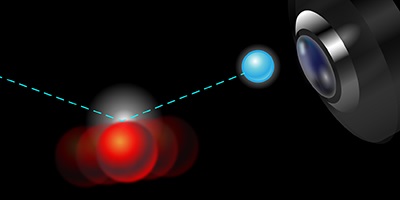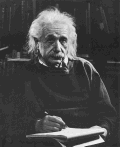|
اصل عدم قطعیت هایزنبرگ را همه میشناسند؛ آن طور
که این اصل میگوید، اندازهگیری، ناگزیر خرابکار
است. چیزی را دستکاری میکنیم تا مشاهدهاش
نماییم؛ و این گونه خطا به اندازهگیریمان راه
مییابد. اما این روزها گفته میشود (اینجا
را نظاره کنید) که خطایی، کمتر از حد
هایزنبرگ دیده شدهاست. مقالهای از Physical
Review Letters، در توضیح این تناقض ظاهری،
فرمولبندی تازهای برای اصل عدم قطعیت معرفی
میکند که در آن اثر مخرب اندازهگیری به شکل
دستگاه اندازهگیری وابسته بوده و با بیشینهی
تغییر در حالت شی سنجیده میشود.

به گزارش انجمن فیزیک ایران، فیزیکدان ها بیشتر
اصل عدم قطعیت را با توجه به چگونگی رسیدن ذرهها
به یک حالت مشخص درک میکنند. مثلا میشود مکان
ذرهی درون جعبه را با هر دقتی تعیین کرد؛ اما
برای تکانه، بازهی مقادیر ممکن بسیار بزرگ
خواهدبود. میشود با دیدگاه دیگری نیز به این
مساله نگاه کرد: اثرهای اندازهگیری. هایزنبرگ،
خود، میکروسکوپی را مثال میزند که در آن،
فوتونها از یک ذره پراکنده میشوند تا مکان آن را
تعیین کنند. هر چه طول موج فوتون کوچکتر باشد،
مکان آن دقیقتر اندازهگیری میشود؛ و البته
تکانهاش بیشتر تغییر میکند. اما به نظر میرسد
که در آزمایشهایی که این روزها انجام میشوند، با
کمک دستهای اندازهگیری «ضعیف»، نابودگری کمتری
نسبت به پیشبینی هایزنبرگ دیده شدهاست.
پاول بوش، از دانشگاه یورک در بریتانیای کبیر، و
همکاران باور دارند که تناقضی وجود ندارد مگر در
تعیین اثر اندازهگیری. پیش از این، خطاهای ناشی
از اندازهگیری به صورت حالت به حالت و با
مقایسهی حالت سامانه پیش و پس از یک اندازهگیری
محاسبه میشدند. اما بوش و همکاران نشان میدهند
که تعیین خطای اندازهگیری، با یک روش مستقل از
حالت، با یک نوع فرآیند تنظیم دستگاه اندازهگیری،
به حدهایی که با اصل عدم قطعیت در توافقاند،
میانجامد.
منبع: http://physics.aps.org/synopsis-for/10.1103/PhysRevLett.111.160405
مرجع: Proof
of Heisenberg’s Error-Disturbance Relation
نقل از
بیگ بنگ
مرز بین ایمان و تجربه
نامه
سرگشاده به حضرت آیت الله هاشمی رفسنجانی
Synopsis: Rescuing Heisenberg
Paul Busch, Pekka Lahti, and Reinhard F. Werner
Published October 17, 2013

The
popular conception of the Heisenberg uncertainty
principle is that measurement is unavoidably
invasive. We disturb an object when we observe
it, thus introducing error into subsequent
measurements. However, recent experiments (see 6
September 2012 Synopsis)
claim to have measurement errors below the
Heisenberg limit. To address this apparent
contradiction, a paper in Physical
Review Letters reports
a new formulation of the uncertainty principle
in which measurement disturbance depends on the
performance of the measuring device, which is
quantified as the maximum possible change in the
state of the object.
Physicists
often characterize the uncertainty principle in
terms of how a particle’s state is prepared. For
instance, placing a particle in a small box lets
us know its position fairly precisely, but it
leaves the momentum with a wide range of
possible values. Another way of looking at this
is through measurement effects. Heisenberg
himself gave the example of a microscope that
scatters photons from a particle to measure its
position. The shorter the photon wavelength, the
more precise the position measurement can be,
but also the greater the disturbance to the
particle’s momentum. However, recent work with
so-called “weak” measurements seems to indicate
that disturbances can be less than Heisenberg
would predict.
Paul
Busch of the University of York in the UK and
his colleagues believe there is no contradiction
here, but only a misunderstanding over how to
characterize the effects of measurement.
Previously, measurement-induced errors have been
calculated on a state-by-state basis, by
comparing the state of a system “before” and
“after” a measurement. But Busch et
al. show
that defining measurement error in a
state-independent way, through a kind of
calibration process of the measuring device,
leads to limits in line with the uncertainty
principle. – Michael
Schirber
Source:
Physics
آخرین
مقالات
1 2 3 4 5 6 7 8 9 10 11 12 13 14 15 16 17 18 19 20 21 22 23 24 25
26 27 28 29 30 31 32 33 34 35 36 37 38 39 40
|



